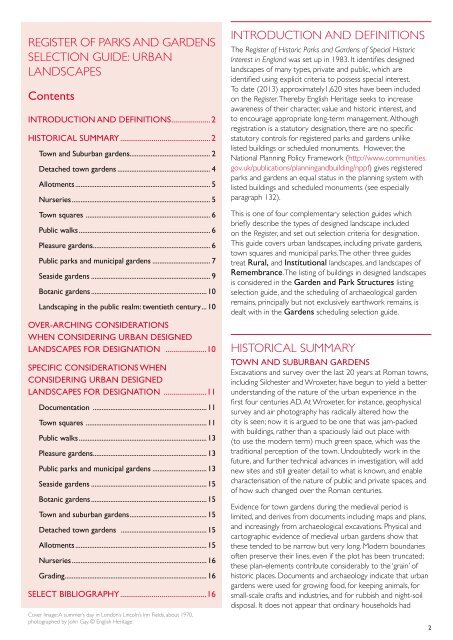Urban Landscapes - English Heritage
Urban Landscapes - English Heritage
Urban Landscapes - English Heritage
Create successful ePaper yourself
Turn your PDF publications into a flip-book with our unique Google optimized e-Paper software.
REGISTER OF PARKS AND GARDENS<br />
SELECTION GUIDE: URBAN<br />
LANDSCAPES<br />
Contents<br />
INTRODUCTION AND DEFINITIONS.....................2<br />
HISTORICAL SUMMARY...............................................2<br />
Town and Suburban gardens.............................................. 2<br />
Detached town gardens...................................................... 4<br />
Allotments.............................................................................. 5<br />
Nurseries................................................................................ 5<br />
Town squares ........................................................................ 6<br />
Public walks............................................................................ 6<br />
Pleasure gardens.................................................................... 6<br />
Public parks and municipal gardens.................................. 7<br />
Seaside gardens..................................................................... 9<br />
Botanic gardens................................................................... 10<br />
Landscaping in the public realm: twentieth century.... 10<br />
OVER-ARCHING CONSIDERATIONS<br />
WHEN CONSIDERING URBAN DESIGNED<br />
LANDSCAPES FOR DESIGNATION ......................10<br />
SPECIFIC CONSIDERATIONS WHEN<br />
CONSIDERING URBAN DESIGNED<br />
LANDSCAPES FOR DESIGNATION .......................11<br />
Documentation .................................................................. 11<br />
Town squares ...................................................................... 11<br />
Public walks.......................................................................... 13<br />
Pleasure gardens.................................................................. 13<br />
Public parks and municipal gardens................................ 13<br />
Seaside gardens................................................................... 15<br />
Botanic gardens................................................................... 15<br />
Town and suburban gardens............................................. 15<br />
Detached town gardens .................................................. 15<br />
Allotments............................................................................ 15<br />
Nurseries.............................................................................. 16<br />
Grading.................................................................................. 16<br />
SELECT BIBLIOGRAPHY.............................................16<br />
Cover Image: A summer’s day in London’s Lincoln’s Inn Fields, about 1970,<br />
photographed by John Gay. © <strong>English</strong> <strong>Heritage</strong>.<br />
INTRODUCTION AND DEFINITIONS<br />
The Register of Historic Parks and Gardens of Special Historic<br />
Interest in England was set up in 1983. It identifies designed<br />
landscapes of many types, private and public, which are<br />
identified using explicit criteria to possess special interest.<br />
To date (2013) approximately1,620 sites have been included<br />
on the Register. Thereby <strong>English</strong> <strong>Heritage</strong> seeks to increase<br />
awareness of their character, value and historic interest, and<br />
to encourage appropriate long-term management. Although<br />
registration is a statutory designation, there are no specific<br />
statutory controls for registered parks and gardens unlike<br />
listed buildings or scheduled monuments. However, the<br />
National Planning Policy Framework (http://www.communities.<br />
gov.uk/publications/planningandbuilding/nppf) gives registered<br />
parks and gardens an equal status in the planning system with<br />
listed buildings and scheduled monuments (see especially<br />
paragraph 132).<br />
This is one of four complementary selection guides which<br />
briefly describe the types of designed landscape included<br />
on the Register, and set out selection criteria for designation.<br />
This guide covers urban landscapes, including private gardens,<br />
town squares and municipal parks. The other three guides<br />
treat Rural, and Institutional landscapes, and landscapes of<br />
Remembrance. The listing of buildings in designed landscapes<br />
is considered in the Garden and Park Structures listing<br />
selection guide, and the scheduling of archaeological garden<br />
remains, principally but not exclusively earthwork remains, is<br />
dealt with in the Gardens scheduling selection guide.<br />
HISTORICAL SUMMARY<br />
TOWN AND SUBURBAN GARDENS<br />
Excavations and survey over the last 20 years at Roman towns,<br />
including Silchester and Wroxeter, have begun to yield a better<br />
understanding of the nature of the urban experience in the<br />
first four centuries AD. At Wroxeter, for instance, geophysical<br />
survey and air photography has radically altered how the<br />
city is seen; now it is argued to be one that was jam-packed<br />
with buildings, rather than a spaciously laid out place with<br />
(to use the modern term) much green space, which was the<br />
traditional perception of the town. Undoubtedly work in the<br />
future, and further technical advances in investigation, will add<br />
new sites and still greater detail to what is known, and enable<br />
characterisation of the nature of public and private spaces, and<br />
of how such changed over the Roman centuries.<br />
Evidence for town gardens during the medieval period is<br />
limited, and derives from documents including maps and plans,<br />
and increasingly from archaeological excavations. Physical and<br />
cartographic evidence of medieval urban gardens show that<br />
these tended to be narrow but very long. Modern boundaries<br />
often preserve their lines, even if the plot has been truncated;<br />
these plan-elements contribute considerably to the ‘grain’ of<br />
historic places. Documents and archaeology indicate that urban<br />
gardens were used for growing food, for keeping animals, for<br />
small-scale crafts and industries, and for rubbish and night-soil<br />
disposal. It does not appear that ordinary households had<br />
2

















